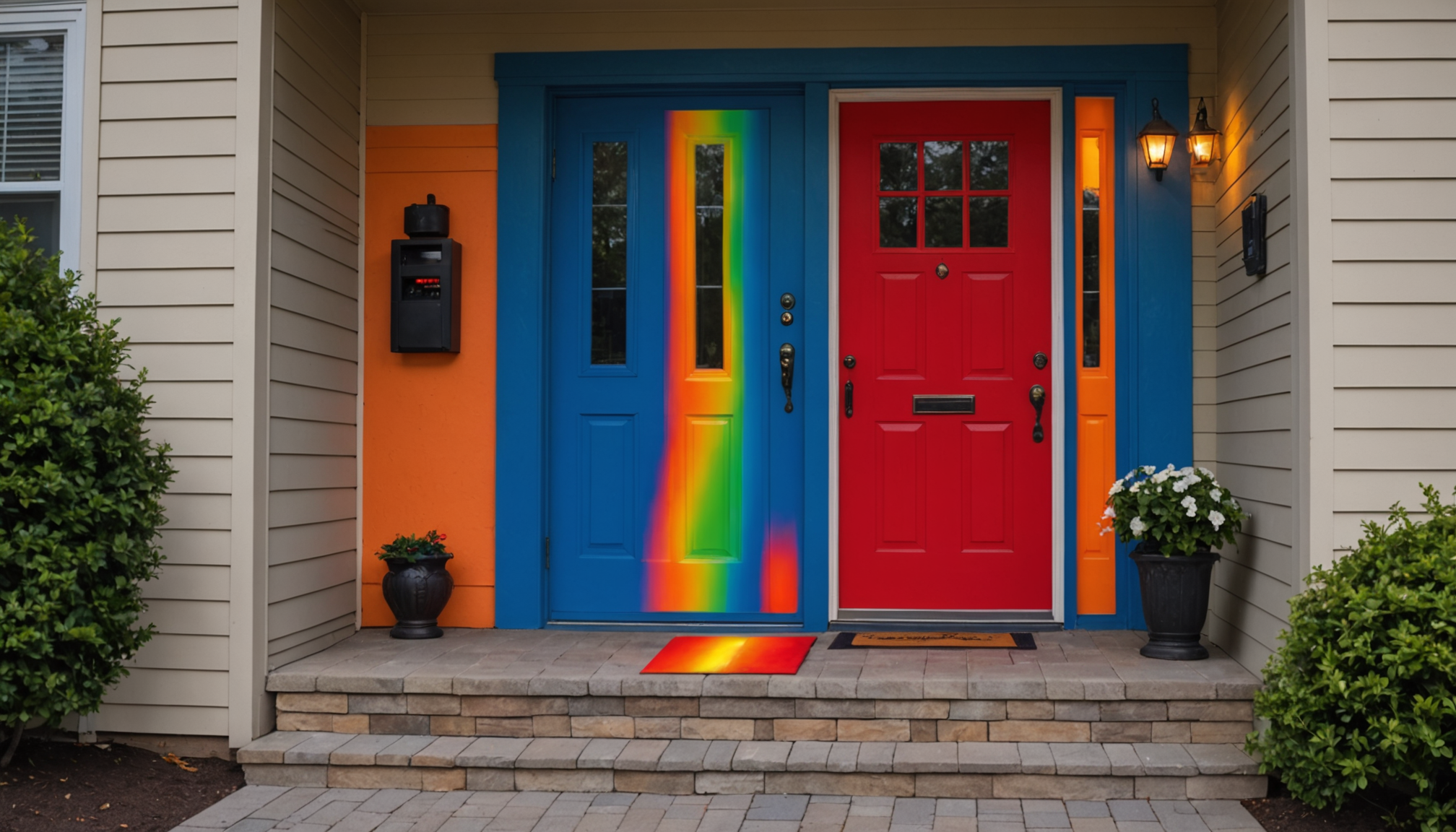Understanding the specific insulation needs of your entryway is a crucial first step before engaging in any DIY renovation project. An entryway serves as a vital point in your home for both thermal regulation and structural integrity. Thus, conducting a comprehensive assessment helps in identifying potential weaknesses and the most effective insulation solutions tailored to your home.
Begin by examining the existing insulation in your entryway. Older homes, for instance, may have insufficient or worn-out insulation due to years of wear and tear. Assess the condition of doors, windows, and any exposed surfaces that directly face the outdoors. Checking for drafts or uneven temperatures around these areas can indicate poor insulation
Next, consider the seasonal impact on your entryway. Changes in weather, from scorching summer days to freezing winter nights, push your home’s heating and cooling systems to work overtime if your entryway isn’t properly insulated. Use a thermal imaging camera or a simple infrared thermometer to detect temperature variations. This can give you a clear visual of where insulation might be failing or needed.
Additionally, evaluate any noise infiltration that might be coming from the entryway. Soundproofing is an integral aspect of insulation that is often overlooked, yet critical for maintaining a serene home environment. Excessive outdoor noise filtering into your home can be a sign that your entryway requires more comprehensive insulating techniques.
To make well-informed decisions, compare the different insulation materials based on their effectiveness, cost, and ease of installation. Consider the table below for a simplified comparison:
| Material | R-Value (insulating capacity) | Cost | Ease of Installation |
| Fiberglass | 2.2 – 2.7 per inch | Moderate | Moderate |
| Spray Foam | 6.0 – 7.0 per inch | High | Professional Installation Recommended |
| Cellulose | 3.1 – 3.8 per inch | Low | Challenging |
| Rigid Foam | 4.0 – 6.5 per inch | Variable | DIY-Friendly |
Once you have pinpointed the insulation needs and potential materials, consider the local climate and how it influences your choice. In regions with severe weather variations, a higher R-value material may be more beneficial in the long run. This holistic approach will ensure that your entryway remains energy efficient, comfortable, and effectively insulated against the elements, thereby enhancing the overall energy efficiency of your home.
selecting the right materials
Before diving into your DIY insulation project, it’s crucial to ensure your entryway is properly prepared. This step lays the groundwork for a seamless insulation process, ultimately enhancing your home’s energy efficiency and comfort. To get started, follow these detailed instructions:
- Clear the Area: Begin by removing any furniture, rugs, or decorations near your entryway. This will provide open space to work and prevent any potential damage to your belongings during the renovation.
- Clean and Inspect Surfaces: Thoroughly clean all surfaces to be insulated, ensuring they are free of dust, dirt, and debris. This includes door frames, window sills, and any other exposed areas. Inspection is vital; look for any signs of moisture, mold, or decay, which should be addressed before proceeding with insulation. Address these issues promptly, as they can compromise insulation effectiveness and structural integrity.
- Seal Gaps and Cracks: Use caulk or expanding foam sealant to fill in any gaps, cracks, or crevices that might allow air to flow through. Focus on areas around door frames, windows, and other joints. This step is essential for preventing drafts and enhancing the performance of your chosen insulation material.
- Check for Moisture Issues: Conduct a moisture test by applying a small amount of water to suspected areas and observing how it behaves. If moisture is an issue, consider using a vapor barrier to prevent dampness from affecting your insulation and entryway materials.
- Evaluate Door and Window Frames: Ensure that frames are in good condition, with no warping or damage. If necessary, reinforce or repair these structures to support the new insulation and maintain energy efficiency.
- Measure Your Entryway: Accurate measurements are critical for obtaining the right amount of insulation material. Measure the height, width, and depth of each area to be insulated, including doors and windows. This will ensure you purchase sufficient materials without waste.
- Choose Supplemental Weatherstripping: For added insulation benefits, choose weatherstripping that complements your primary insulation material. This serves as an additional barrier against air leakage and helps maintain consistent indoor temperatures during seasonal changes.
- Gather Tools and Supplies: Assemble all necessary tools, such as a utility knife, measuring tape, caulking gun, and safety gear like gloves and goggles. Having everything on hand will streamline the installation process and minimize interruptions.
By diligently preparing your entryway, you establish a solid foundation for the insulation phase. This proactive approach not only enhances the effectiveness of your insulation efforts but also contributes to the overall durability and comfort of your home, particularly during seasonal changes when thermal efficiency is most critical.
preparing your entryway for insulation
With your entryway properly prepared, you are now ready to embark on the insulation phase of this DIY renovation project. Proper preparation ensures that the work you undertake will be effective, long-lasting, and capable of withstanding seasonal variations that can affect your home’s overall comfort and energy efficiency. By following these careful preparation steps, you have set the stage for a successful insulation process that not only blocks drafts and noise but provides a sturdy barrier against the elements.
One of the key benefits of this meticulous preparation is the optimization of the insulating materials’ performance. By addressing structural concerns such as cracks, moisture, and the condition of door and window frames, you prevent heat loss and enhance thermal resistance, ensuring you get the maximum value from your chosen insulation materials. This proactive attention to detail helps maintain the entryway’s functionality and appearance, preserving both aesthetic and structural integrity.
Moreover, preparation equips you with the foresight needed to select the most appropriate materials tailored to your specific insulating needs and climate conditions. This strategic approach lets you choose materials with the right R-value and durability, enhancing your home’s ability to resist temperature fluctuations. Such careful planning not only saves you money in energy bills by improving your entryway’s energy efficiency but also reduces the frequency of future maintenance and repairs.
Additionally, ensuring all surfaces are clean and free from obstructions fosters a seamless application process. This eliminates potential barriers such as dust and debris, which could otherwise inhibit adhesion and effectiveness. Notably, using high-quality sealants to close gaps and applying weatherstripping provide additional layers of defense against air leakage. These combined efforts translate into a longer-lasting insulation solution that sustains your home’s comfort level during various seasonal changes.
As you prepare to insulate your entryway, gathering the right tools and materials is another preparatory step that enhances efficiency and safety. By having everything ready, including personal protective equipment, you streamline the process, minimize downtime, and avoid unnecessary interruptions—a crucial aspect for any DIY enthusiast aiming to complete home improvements successfully.
Thus, the groundwork you’ve laid through thoughtful preparation significantly contributes to the success of your insulation project, transforming your entryway into a well-insulated barrier that offers comfort, efficiency, and a reduction in energy costs year-round, regardless of external weather conditions.
step-by-step insulation process
With the groundwork firmly laid, it’s time to dive into the core of your DIY renovation project—insulating your entryway. Each step in this methodical process plays a vital role in ensuring your home’s energy efficiency and comfort are fully optimized through varying seasonal conditions. Carefully follow the instructions below to execute a flawless insulation job that will stand the test of time.
Start first by settling on which insulation material you’ve chosen, whether it’s fiberglass batts, spray foam, rigid foam, or another type. Each material has its specific techniques for setup, so always adhere to the manufacturer’s guidelines for installation. Safety gear is a must, so ensure you’re wearing gloves, goggles, and masks as needed, especially when handling materials like fiberglass that can be irritating.
Tackle larger surfaces such as walls by selecting appropriately sized insulation pieces. For fiberglass batts or rigid foam, cut the material to fit snugly between wall studs or surface areas, ensuring minimal gaps. Use a utility knife for precision cutting and consider trimming slightly larger sections to achieve a tighter fit—compression can slightly enhance thermal resistance. When dealing with spray foam, apply it in a thin, even layer, carefully filling crevices to expand adaptively.
Seal the perimeters of your insulation layers with caulking or tape to ensure no gaps remain for air to penetrate. This also serves to reinforce the insulating material and prevent it from shifting over time. Be particularly attentive around the frames of doors and windows, as these are common sites for drafts. Applying a layer of caulk here provides an airtight seal, further bolstered by your chosen insulation material.
Next, apply weatherstripping around doors and windows to fortify their defense against seasonal weather. Measure the perimeters accurately and cut the weatherstripping to fit, adhering it along the edges of doors and windows to establish a tight, comprehensive seal. This is an important step that works in conjunction with your primary insulation layer to create effective thermal and noise barriers.
For the final touches, inspect your work thoroughly. Check for leftover gaps or inadequately covered areas and address them immediately to avoid compromising your hard work. Once every segment is satisfactorily insulated, replace any fixtures or decorations you removed during the preparation stage. By periodically checking the integrity of seals and ensuring materials remain intact, your entryway will continue to benefit from reduced energy loss and enhanced indoor comfort.
This strategic insulation process not only boosts your home’s energy efficiency but also paves the way for lower energy bills and a quieter, more comfortable living environment. By taking a detail-oriented approach, your entryway becomes not just an entrance, but a fortified barrier against whatever seasonal challenges the outside world throws your way.
maintenance tips and best practices
Regular upkeep of your entryway insulation is critical to ensure its longevity and efficiency, providing consistent benefits in energy savings and indoor comfort. By following a robust maintenance routine, you can maximize the life of your insulation while keeping your home well-protected against seasonal temperature fluctuations.
Begin by conducting regular inspections throughout the year, focusing on the integrity of seals around doors and windows. Look for signs of wear or detachment in weatherstripping, as these can lead to air leaks and diminished insulation performance. Replace any compromised weatherstripping promptly to maintain an effective barrier against drafts and noise pollution.
Similarly, check any caulked areas to ensure the seals remain intact. Over time, caulk can crack or peel due to natural settling of your home or due to environmental factors such as humidity and temperature changes. Reapply caulk where it has degraded to prevent air seepage and preserve your entryway’s thermal resistance.
For those who have used materials like fiberglass or foam, it’s important to monitor for any signs of moisture intrusion. A persistent issue with dampness can deteriorate insulation materials and promote mold growth, which compromises both the structural integrity and air quality of your home. Should you detect moisture, investigate and remedy its source—be it a leaky roof, poor drainage, or inadequate vapor barriers—to protect your insulation investment.
Don’t overlook routine cleaning as part of your maintenance regimen. Keeping the surfaces around your entryway insulation free from dust and debris can enhance the performance of the materials by preventing interference with adhesion or surface integrity.
Additionally, consider scheduling a professional assessment every few years to evaluate the overall condition of your entryway insulation. Professionals can provide insights into areas that may need attention before minor issues escalate into costly repairs. This proactive approach helps maintain the effectiveness of your DIY renovation efforts and prolongs the life of your insulation.
In nurturing the state of your insulated entryway, you not only secure a comfortable living environment but also keep your home energy-efficient year-round. This results in reduced utility costs, amplified home value, and fortification against the changing seasons—a worthy return on your initial effort and investment.
In conclusion, successfully insulating your entryway involves more than just selection and installation. It’s an ongoing commitment to maintain and inspect the components that fortify your home against temperature extremes. By adhering to these maintenance tips and best practices, you ensure that your entryway remains a robust, energy-efficient barrier, contributing to the overall comfort and sustainability of your home for years to come.


